
Feature Article
Guardians of the Plate: The Vital Role of Food Surveillance Programme
It is everyone's duty to maintain food safety. Both consumers and the food businesses should include the Five Keys to Food Safety in their daily routines to prevent foodborne diseases. The Codex Alimentarius Commission (Codex) provides detailed principles and guidelines for food control systems. Codex pointed out that an effective food control system is essential for ensuring the safety and suitability of food for consumers and ensuring fair practices. Additionally, food surveillance is a crucial component of an extensive food control system that enhances food safety and public health. This system includes upstream measures such as import protocols for high-risk foods, regulations and standards, and downstream activities like food surveillance, all working in collaboration.
As advocated by Codex, one key principle of an effective food control system is the adoption of a whole food chain approach to food surveillance, ensuring that monitoring occurs at various stages — from farm to table — to proactively detect and mitigate risks before products reach consumers. Practices in food surveillance vary widely across different regions, reflecting each area’s unique challenges, regulatory environments, adherence to international standards and levels of development.
Food Surveillance in Hong Kong
Food surveillance involves the continuous monitoring and assessment of the food supply chain to detect and address risks associated with food safety. This proactive approach helps in identifying potential hazards before they cause harm, ensuring that corrective actions can be implemented swiftly. Surveillance data are crucial for risk assessment and management, guiding policy decisions and prioritising regulatory focus.
In Hong Kong, the Food Surveillance Programme (FSP) conducts safety tests on about 65 000 food samples each year, which translates to about 9 samples per 1 000 people, a sampling rate that is relatively higher compared to other jurisdictions. To protect public health, it is essential to maintain vigilant oversight and take immediate risk management steps in response to any unfavourable outcomes from the FSP.
Main Features of the Centre for Food Safety (CFS) Food Surveillance Programme
Throughout the year, the CFS collects food samples at various levels including import, wholesale, and retail/catering. Dedicated food control offices at the border ensure timely collection of samples from foods imported via different routes. Additionally, samples are systematically gathered from wholesale markets, retail outlets, food factories and restaurants. With the rise of online shopping, a portion of retail samples are now procured through online platforms, reflecting the changing consumer behaviour towards internet shopping.
The CFS's FSP monitors a broad spectrum of foods and potential risks, incorporating seasonal variations. It includes routine, targeted, and seasonal surveillance projects. Routine surveillance covers major food groups like vegetables, fruits, poultry, aquatic products, dairy products and eggs, ensuring their compliance with food safety standards. Targeted surveillance addresses specific risks such as illegal addition of sulphur dioxide in fresh meat or the presence of Cronobacter sakazakii in infant milk powder. Seasonal surveillance aligns with cultural festivals or seasonal consumption patterns, such as examining rice dumplings during the Tuen Ng Festival period or mooncakes during the Mid-Autumn Festival period to ensure food safety during peak consumption periods.
Risk-based Sampling and Test Selection
A risk-based approach is adopted for the selection of food samples and testing parameters, prioritising high-risk foods, previous unsatisfactory samples, reports of local or overseas food incidents, intelligence and public concerns. An internal review is conducted regularly to reflect new legislation and standards. The testing scope includes chemical, microbiological and radiological hazards, ranging from food additives and contaminants to pathogens and radiological parameters, as well as antimicrobial resistance bacteria (Figure 1).
The FSP is reviewed by the Expert Committee on Food Safety before implementation. Additionally, a working group focuses on the unique challenges arising from food purchased via online platforms, adapting surveillance methods to this modern shopping trend. The outcomes of these surveillance activities and the progress of the working group are reported regularly to the Panel on Food Safety and Environmental Hygiene of the Legislative Council, contributing to transparency and continuous improvements in food safety practices.
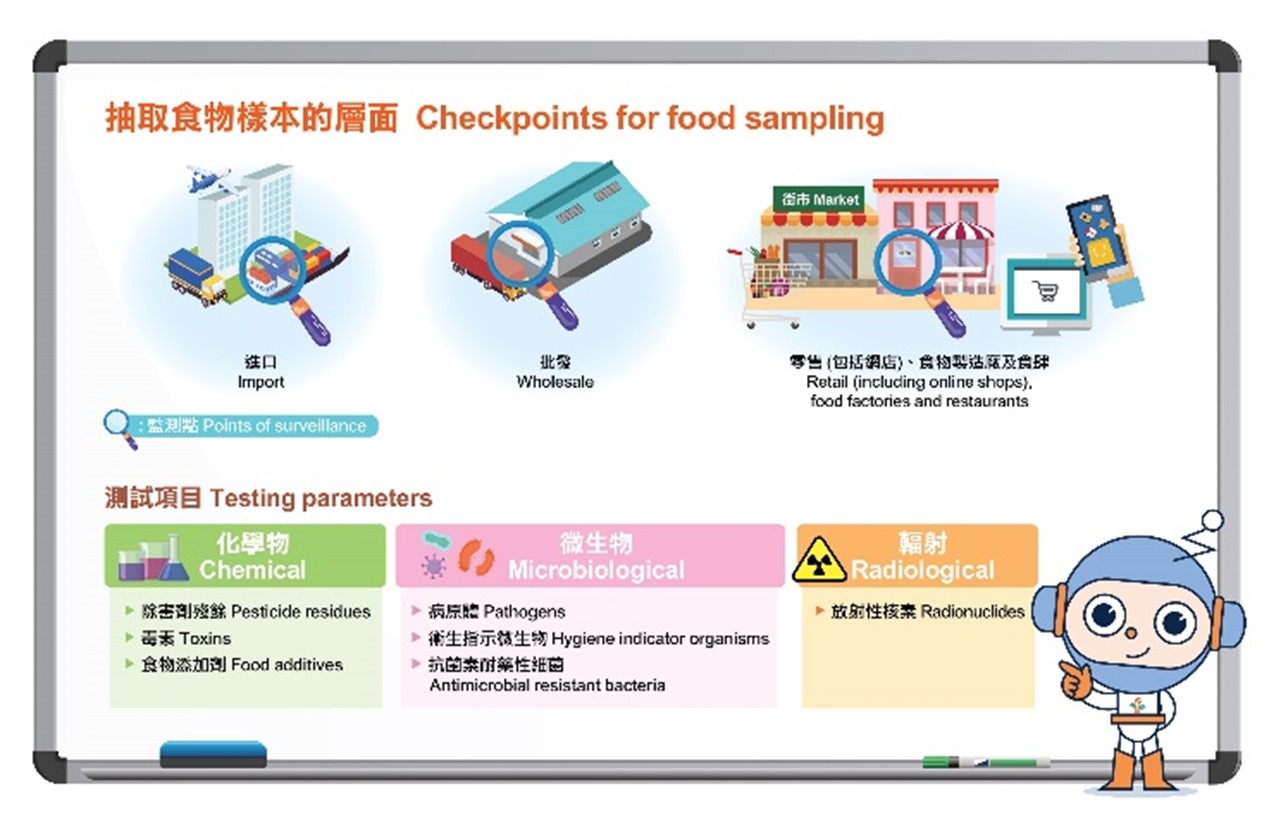
Figure 1: The Food Surveillance Programme of the CFS monitors the safety of different types of food at different levels
How does the FSP Safeguard Food Safety
The FSP is an important component of the food safety framework, engaging in risk-based monitoring to ensure food safety and compliance with standards. It not only systematically collects a wide array of food samples for analysis of contaminants like pathogens, chemical residues and toxins, but also enforces regulatory compliance and prosecutes non-compliant entities. Enforcement is crucial for keeping pace with new regulations. Furthermore, the FSP supports risk management and communication strategies, ensuring the public is kept informed of essential food safety information through clear reporting and dissemination. This is achieved via press releases, social media and other platforms when samples do not meet safety standards. Other risk management measures, including source tracing, product recalls, notification to the place of origin and import suspension, are also implemented. Food Safety Reports are released regularly to keep the public informed.
In summary, the CFS upholds food safety through rigorous surveillance, ensuring compliance, and acting promptly to address any issues related to unsatisfactory results. This proactive and comprehensive approach is vital for preventing foodborne diseases and protecting public health.
Mascot ON in Lesson
1. Methoxychlor in Food
Methoxychlor (MXC) is an organochlorine pesticide and is currently prohibited for use in agriculture in many countries. MXC persists in the environment and has a strong potential for long-range environmental transportation. The CFS has conducted a risk assessment study to estimate the dietary exposure to MXC of the local adult population and assess the associated health risk.
The study results showed that the dietary exposures of the local adult population were much lower than the acceptable daily intake established by the Joint Food and Agriculture Organization/World Health Organization (WHO) Meeting on Pesticide Residues (i.e. 100 µg/kg bw per day). Hence, the health concern for the local adult population due to their MXC exposure upon usual consumption of food was low and changes to the basic dietary advice on healthy eating were not justified.
To remove pesticide residues in agricultural products while retaining their nutritional values, members of the public could wash them thoroughly under clean running water and scrub produce with hard surfaces with a clean produce brush to remove dirt and substances including pesticides and contaminants.
2. Safe Use of Oil for Deep-frying
Deep-fryingNote 1 is a popular cooking method which can add crispiness and a golden colour to food. When deep-frying, steps can be followed to minimise undesirable chemical reactions and enhance food safety and quality.
Select oil with higher levels of monounsaturated fatty acids like rapeseed oil and high-oleic sunflower oil, as they are more resilient at high temperatures. Moisture in food should be minimised and excessive batter and breadcrumb coating should be avoided. Keep the oil temperature between 150°C and 180°C as too high of a temperature can accelerate the breakdown of oil and the production of process contaminants like glycidyl esters (GE) and 3-monochloropropane-1,2-diol esters (3-MCPDE), while too low of a temperature will increase the amount of oil absorbed. Reduce the oil temperature to 120 - 130°C when idling. Cover the oil to minimise the exposure to light and air when heating is off. Remove residues and clean the fryer regularly. Change the frying oil when it has an unusual colour or odour, or starts to smoke or foam.
Note 1: To learn more about “Tips for Using Deep-frying Oil”, please visit the following webpage or scan the QR code.
https://www.cfs.gov.hk/english/multimedia/multimedia_pub/multimedia_pub_fsf_160_02.html
Spot Check
How to Choose Congee Wisely to Avoid High Sodium Intake
The CFS released the study results on the sodium content in Chinese congee in December 2023. Although none of the samples were considered “high” in sodium (i.e. over 600mg/100g), the sodium intake from consuming one bowl of certain types of congee, such as congee with pig’s liver, may already reach the World Health Organization (WHO)’s recommended daily intake upper limit due to the considerable volume consumed. In this article, we will explore how to reduce sodium intake and healthier ways to eat this traditional Chinese favourite.
WHO Guidelines on Reducing Sodium Intake
Excessive sodium intake is closely related to hypertension, which is a risk factor for non-communicable diseases including cardiovascular diseases and stroke. WHO recommends a daily salt intake of less than 5g (i.e. around 2 000mg of sodium) for adults. In Hong Kong, according to the Population Health Survey 2020-22 conducted by the Department of Health, persons aged 15-84 consumed 8.5g of salt (i.e. around 3 400mg sodium) per day, which exceeded WHO’s recommendation of salt intake per day for adults. Therefore, it is important to reduce dietary sodium intake for Hong Kong people.
Risk Assessment Study on Sodium Content in Chinese Congee
The Study
174 samples, including 12 types of Chinese congee with ingredients, as well as the plain congee base and seasoned congee base available as the choice of congee base for cooking, were collected from local Chinese restaurants, fast food restaurants and congee shops for analysis of their sodium content. The study results are shown in the table below. The sodium content of all samples of congee with ingredients ranged from 33mg/100g to 460mg/100g, with an average of 270mg/100g. The wide variations in the sodium content observed within the same type of congee samples suggested the potential for sodium reduction in these congees by the trade. The sodium content of a plain congee base was substantially lower than that of a seasoned congee base, indicating that the sodium intake from the consumption of congee can be lowered to a great extent by choosing plain congee instead of seasoned congee as the base for making congee with ingredients.
Congee Types with the Highest Sodium Content
Congee with pig’s liver, congee with chicken, congee with pig giblets and congee with preserved egg and pork had the highest average sodium content. This is probably due to the naturally higher sodium content in liver and other internal organ meats, and the higher amounts of seasonings typically used to marinate chicken, pork and other meat ingredients.
Congee Types with the Lowest Sodium Content
Congee with pumpkin, congee with fish and congee with sweet corn had the lowest average sodium content because vegetable ingredients and fish are usually not seasoned/marinated before cooking, while ginger and spices are often added instead to fish fillets used to make congee.
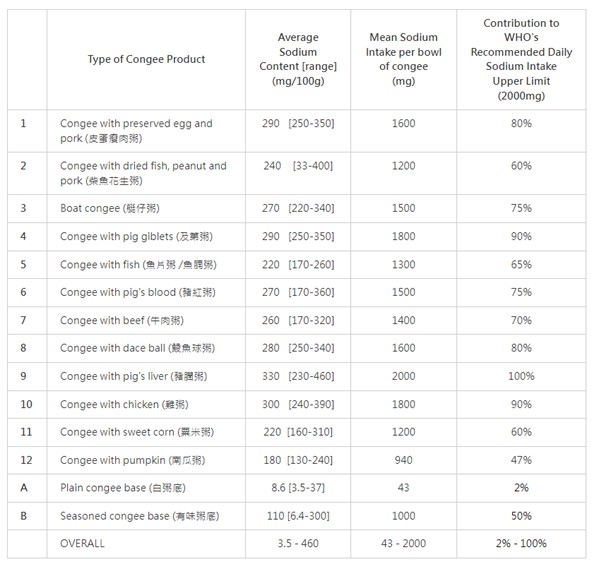
Sodium content and sodium intake per bowl of congee (contribution to WHO’s recommended daily sodium intake upper limit)
Healthier Ways to Eat Congee to Take in Less Sodium
There are healthier ways to enjoy congee to avoid excessive sodium intake: choosing ingredients with lower sodium content such as fish and vegetables, choosing less internal organs and meat with high sodium content, sharing the congee when the portion is large and requesting plain congee instead of seasoned congee as the base, which can significantly lower the sodium intake from congee. The trade should strive to use less salt and seasonings in preparing congee bases and ingredients, offer the choice of smaller portions of congee to consumers, and provide plain congee with little or no salt added as an alternative to the regular seasoned congee base. Furthermore, using less salt or seasonings when preparing congee at home is a great way to control and reduce the amount of sodium intake.
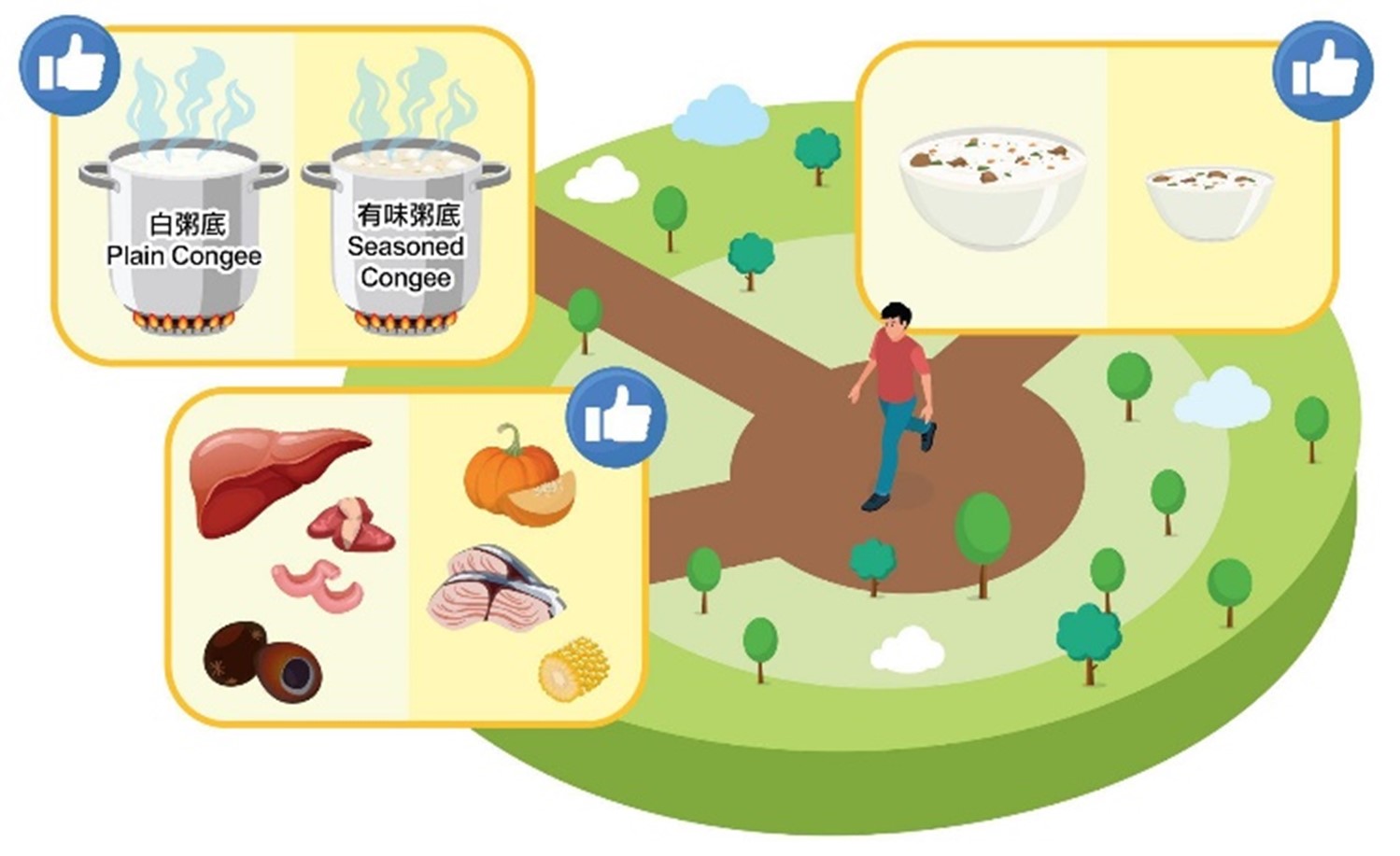
Make healthy choices to reduce the amount of sodium intake from congee: choose ingredients with lower sodium content such as fish and vegetables, choose plain congee with little or no seasonings added as the base, and consume congee in smaller portions
Advice to the Trade
- Reduce the sodium content of the congee base and that of congee with ingredients through product reformulation by making reference to the CFS’s “Trade Guidelines for Reducing Sodium in Foods” (e.g. choosing ingredients with lower sodium content, and using natural ingredients for flavouring and marinating).
- Provide the choice of plain congee with little or no seasoning added as the base for cooking congee with ingredients.
- Apart from providing the standard portion size of congee, offer congee in a smaller portion size for consumers to choose based on their needs.
Safe Kitchen/Trade Talks/Food Safety Regulations
Safe Kitchen
Introduction to “Safe Kitchen” Scheme
To facilitate the adoption of the 5 Keys to Food Safety and Good Hygiene Practices (GHPs) by trade members, and ensure food safety in their daily operation, the CFS has integrated the existing channels of risk communication and launched a new platform, namely “Safe Kitchen”, to communicate with the trade. The platform provides food safety information of greater practical importance to meet the operational needs of catering outlets.
The “Safe Kitchen” platform disseminates up-to-date food safety information (including food safety guidelines and relevant legislative amendments) to the trade through a host of channels including WhatsApp, emails and dedicated websites. In response to food poisoning outbreaks in restaurants, the platform will also issue food alerts to remind the trade of the points to note in preventing future occurrences so that the risk of food poisoning can be minimised.
New dedicated websites and risk information exchange platforms will be rolled out under the “Safe Kitchen” Scheme. In addition, training materials tailor-made for the trade and workshops for kitchen staff will be provided to enhance food safety and hygiene awareness among them. Members of the trade are welcome to scan the QR code to download the registration form for the “Safe Kitchen” Scheme in order to receive the latest food safety information in a timely manner.
Trade Talks
Trade Talks 2025
The CFS has organised food safety talks and workshops on GHPs for Food 2025 from March through October to publicise proper food handling among food trade practitioners, with a view to promoting GHPs for Food through the trade’s active participation and collaboration with the government, and facilitating the trade’s implementation of a Food Safety Plan in the food manufacturing process, so as to enhance food safety.
The talks will be conducted in Cantonese. Participants will be awarded a certificate of attendance. Scan the QR code for more details.
Food Safety Regulations
It is an Offence to Bring any Raw Game, Meat, Poultry or Eggs (except Fully Cooked Eggs) without Health Certificates into Hong Kong
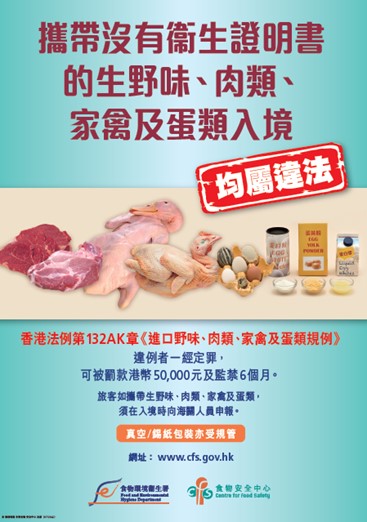
According to the Imported Game, Meat, Poultry and Eggs Regulations (Cap. 132AK), it is an offence to bring game, meat, poultry or eggs into Hong Kong without a health certificate issued by an issuing entity of the place of origin and/or prior permission in writing from the Food and Environmental Health Department. Upon conviction, an offender shall be liable to a fine of HK$50,000 and imprisonment for six months. Food packaged in vacuum/foil is also regulated.
Travellers should note that under normal circumstances, issuing entities of different places only issue health certificates to food traders for business purposes. Persons who wish to obtain such certificates for bringing game, meat, poultry or eggs into Hong Kong should check with the relevant issuing entity in the place of origin and make application where there are arrangements for issuance of health certificates to individuals.
News on CFS
- CFS’s Online Seminar on Handling of Ready-to-eat Food

The CFS is committed to ensuring food safety. To raise the awareness of food safety among staff of food factory producing ready-to-eat food, the CFS held an online seminar on 5 September to remind food workers to follow Good Hygiene Practices (GHPs) and maintain good personal and environmental hygiene at all times.
For more information on ready-to-eat food, please scan the QR code.
- FEHD strives to enhance food safety of catering services for tour groups

The Food and Environmental Hygiene Department (FEHD) has launched a special round of operations to inspect food premises serving tour groups in various districts of Hong Kong with reference to the list provided by Travel Industry Authority, with the aim of enhancing food safety and hygiene awareness among the caterers.
The inspections, being carried out jointly by the Centre for Food Safety (CFS) and Environmental Hygiene Branch since September 12, 2024 are to ensure that the licensing conditions regarding food handling and processing are observed by the operators, and that the hygienic standards stipulated in the laws are met. During the inspections, FEHD staff also provide food safety and hygiene education to operators and their employers, and collect food samples for testing."
Furthermore, the CFS collaborated with the Travel Industry Authority to host an online health talk for tour group catering service providers on September 13, 2024 to provide advice on safe food preparation and remind them to maintain good personal, food, and environmental hygiene at all times. Caterers were also encouraged to adhere to Good Hygiene Practices and develop a food safety plan based on the Hazard Analysis and Critical Control Point system.
The FEHD will continue to monitor the situation and maintain close liaison with relevant stakeholders to safeguard public health and ensure that food safety standards are upheld.
For more information on the relevant “Food Safety Focus”, please scan the QR code.
- The 86th Meeting of the Trade Consultation Forum
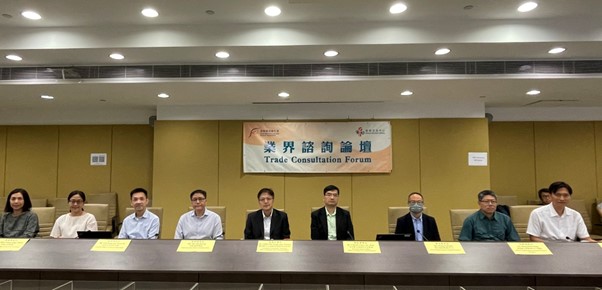
The 86th meeting of the Trade Consultation Forum was held on 20 September. The CFS and the trade exchanged their views on various topics including “Food safety guide for food recovery programmes”, “Food labelling and nutrition labelling of prepackaged food”, “Utilisation of Hong Kong-Zhuhai-Macao Bridge for import of fresh produce”, “Advance release arrangement for Hong Kong-Manufactured food products entering the Mainland Market”, and “Revised fee for application for Recommendation on Food Manufacturer Registration (applicable to export of the specified 18 categories of food products to the Mainland)”. For details of the event, please visit:
https://www.cfs.gov.hk/english/committee/Notes_and_Presentation_Materials_TCF86_20240920.html
Ask Our Mascots
Food Safety Hazards of Raw Oysters
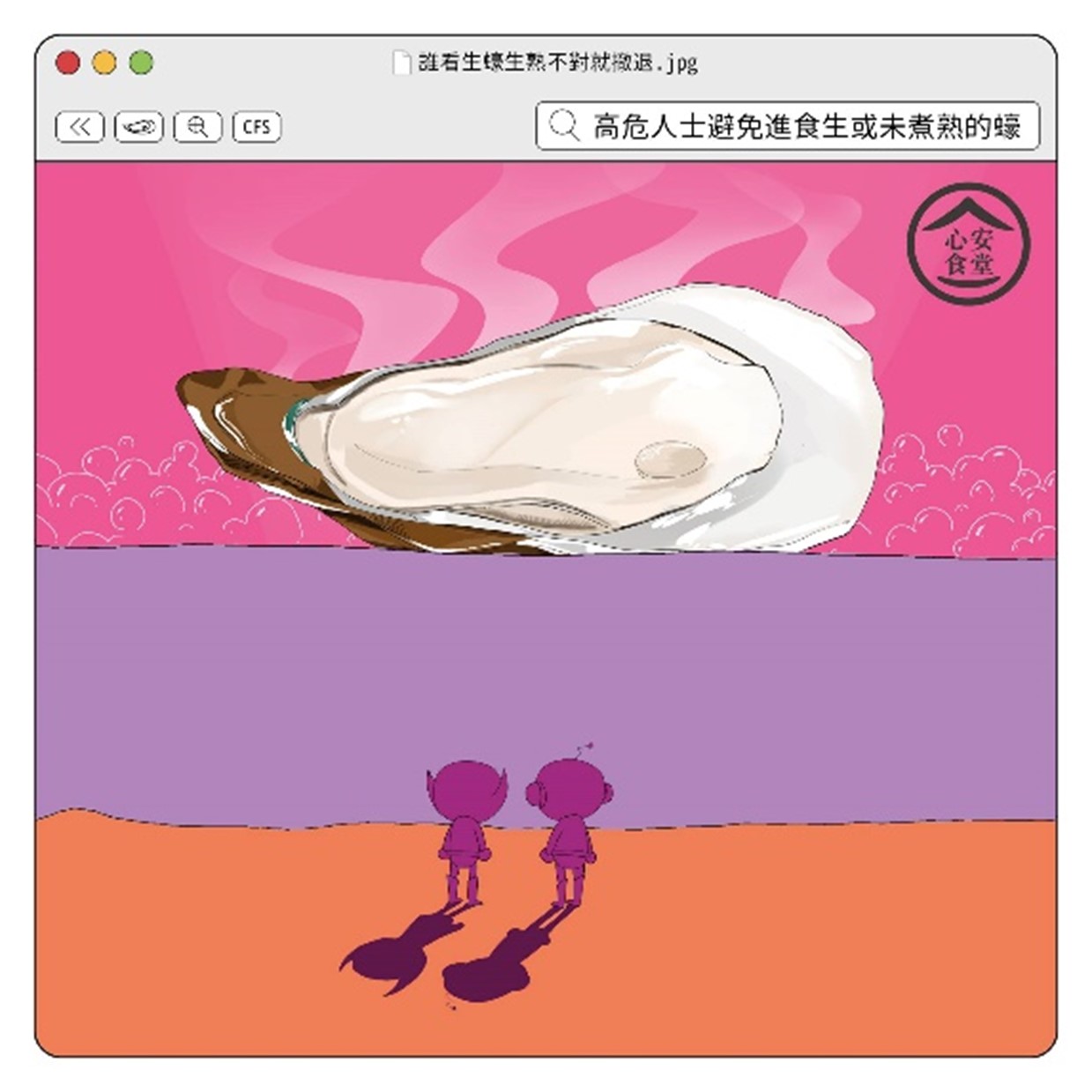
Raw oysters available on the market can be generally categorised into whole-shell, half-shell and pre-shucked raw oysters (such as those packed in tubs or boxes). Feeding by filtering seawater, oysters are susceptible to contamination if the waters in which they grow carry pathogens such as norovirus.
It is worth noting that pre-shucked raw oysters carry a higher microbiological risk than oysters with shell do because pre-shucked raw oysters are more prone to be cross-contaminated during the handling processes, which involve various manual and machinery work. In addition, oysters die after shucking, and their flesh is therefore more perishable. Without proper temperature control during transportation or storage, the oyster flesh may deteriorate quickly, resulting in the multiplication of bacteria and hence a higher food poisoning risk to consumers.
Raw oysters, served without cooking to destroy pathogens and viruses, carry some inherent microbiological risks. Susceptible populations, including pregnant women, young children, the elderly and the immunocompromised, should refrain from consuming raw or undercooked oysters.
The most effective way to destroy pathogens that may be present in oysters is to cook them thoroughly, i.e. heating them to a core temperature of 90℃ for 90 seconds. If you really want to eat raw oysters, make sure to patronize reliable licensed shops or restaurants only. The sale of seafood, such as raw oysters, for raw consumption requires written permission/endorsement from the Director of Food and Environmental Hygiene.
Enhancement Quiz
1. Are the dietary exposures of the local adult population higher than the acceptable daily intake established by the Joint Food and Agriculture Organization/World Health Organization?
- Yes
- No
- Not mentioned
- Can’t tell
2. What is the microbiological risk of pre-shucked raw oysters (such as oysters packed in tubs or boxes) as compared to oysters with shell?
- Lower
- The same
-
Higher
-
Cannot be compared
3. Which one of the following congee has the highest sodium content?
-
Congee with pumpkin
-
Congee with fish
-
Congee with pig’s liver
-
Congee with sweet corn

Diary of Mascot ON
Risk of Unpasteurised Dairy Products
Unpasteurised milk and milk products are inherently high-risk as they can harbour food-borne pathogens. There have been overseas reports of outbreaks of E. coli, Salmonella, Listeria, Campylobacter, etc. associated with raw milk. Recently, the first reported outbreak of a highly pathogenic avian influenza (HPAI) A(H5N1) virus (“H5N1 bird flu”) in dairy cows in the United States and the subsequent suspected single human case via exposure to dairy cows in early April 2024 have raised food safety concerns.
In terms of food safety, some overseas authorities recommend the public not to consume unpasteurised or undercooked milk or its products (e.g. raw milk, raw milk cheese) including those from suspected or confirmed HPAI infected animals. Pasteurisation or sterilisation have been proven to be able to inactivate or eliminate bacteria and viruses, including HPAI, in milk and milk products.
Locally, all liquid milk for sale has to be heat-treated, while unpasteurised milk can be used to make some specialty cheeses. Susceptible populations Note 1 should avoid consuming unpasteurised milk and its products.
Note 1: To find out who the susceptible populations are, please visit the following webpage:
https://www.cfs.gov.hk/english/whatsnew/whatsnew_act/High_Risk_Food_high_risk_population.html